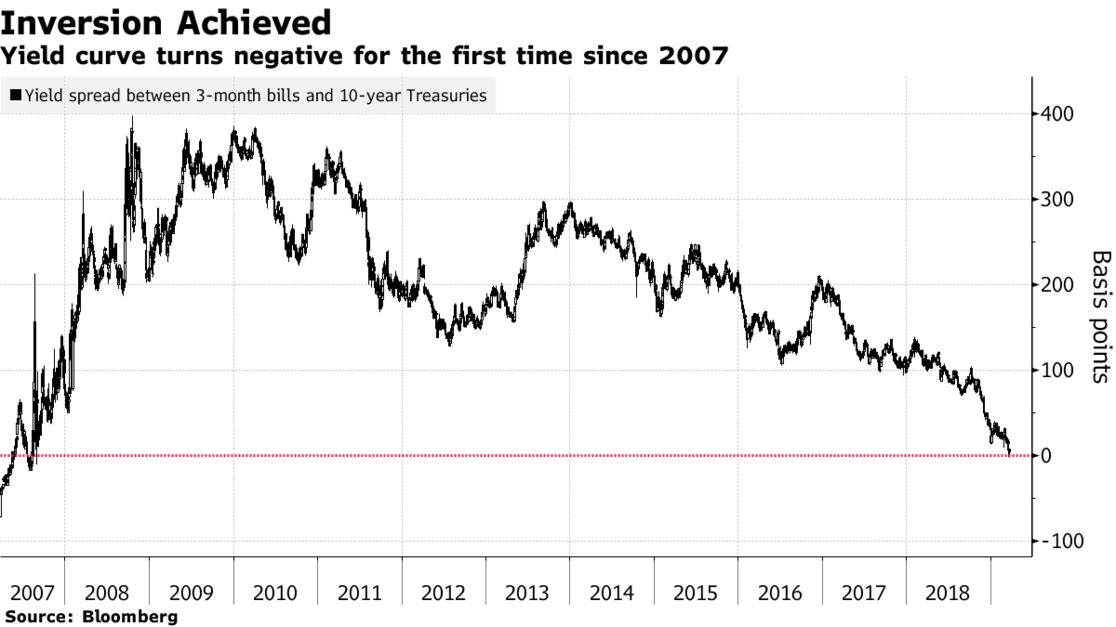The Yield Curve Inverted! Recession Alert?
A Primer on Yield Curves + Is there a Recession Ahead?
by Kevin Huang and Michael Tan [first guest writer appearance on this blog!]Several days ago, Duke Law School and the Fuqua School of Business hosted a conference commemorating the 2008 Financial Crisis – an event deemed by as the worst financial crisis since the Great Depression 80 years prior. Just earlier today (3/22/19), the US Treasury yield curve inverted. The yield on the US 3-month treasury note is now higher than the yield on the 10-year note. The last time this happened was in 2007 – shortly before the start of the Financial Crisis.
(By the way, this is a very exhilarating day for finance geeks like us — truly a once-in-a-decade occurrence worth getting excited over.)

What is a yield curve? The yield curve that I am referring to relates the yields on different duration US Treasuries to each other. A US Treasury is a loan that anyone can give to Uncle Sam, with the stipulation that at the end of the maturity date, whether it is 6 months, 2 years, or 30 years, you will be paid back the original loan amount, plus a “coupon” that is predetermined. The yield relates the current price of a Treasury to its coupon, which is a fixed amount. As the Wall Street Journal likes to say, yields rise when prices fall.
In general, yields on shorter maturity Treasuries will be lower than their longer-dated counterparts, due to the interest rate risk associated with a longer time period. It is harder to predict what will happen in 10 years than in 3 months — there is more uncertainty and thus purchasing a 10-year note is a riskier exercise than purchasing a 3-year note. Accordingly, investors should be compensated with a higher yield as the length of their investment period increases (i.e. the maturity date of the bond). Therefore, you can imagine that in normal circumstances if you plot yield on the Y-axis and time on the X-axis, you will have an upward sloping line. An inverted yield curve occurs whenever the yield on a treasury is lower than any treasury that has a shorter maturity. Why does it matter that it inverted?
Well, it might not. The inversion of the yield curve is seen by many as a leading indicator of some sort of financial crisis or recession, but we certainly cannot prove causation – only that the two are correlated. However, this is true of any indicator, and indicators are imperfect. The reason that people watch this particular indicator so closely has to do with the investors’ beliefs about future economic conditions. If expectations for the economy are weak, investors tend to flock to the usually higher-yielding longer-dated Treasuries instead of short-term bonds. This drives the long-dated Treasury prices up, and their yields down, and inversely so for the sell-off of short-term Treasuries. Intuitively, think about it this way: If I have faith in the economy in the short term, I'd be happy to invest in a short term note. But if I think the economy is super volatile and uncertain and I have no faith/idea in what will happen in the short term, then I'll probably be more comfortable investing in the more long-term bonds versus locking my money up in a short-term investment under dubious short-term economic conditions.
Ironic, then, that the conference on the 2008 Financial Crisis was held a mere 2 days before the news of the inverted yield curve broke. At the conference, attendees got to hear from a variety of titans in the financial industry – names like David Rubinstein, John Mack, and Alan Schwartz. John Mack, then-CEO of Morgan Stanley, spoke about the importance of relationships in saving his company. In one anecdote, he mentioned how a foreign-exchange training program he started with Japan in the 70s paid dividends in 2008, when he was able to convince Mitsubishi to acquire $9 billion of Morgan Stanley, saving Morgan Stanley from what was likely to be bankruptcy.
10 years of economic prosperity and the longest bull-run in United States history sparks the question: When is the next recession going to happen, and what will it be? With the inverted yield curve, many think that the recession will happen sooner rather than later. As for what will be its cause, people have thrown around anything from student loan debt to the current US-China Trade War. If history repeats itself, the next recession will arise from the issue that people least expect. The only thing we can do is be prepared to face the music when it inevitably happens.
Comments
Post a Comment